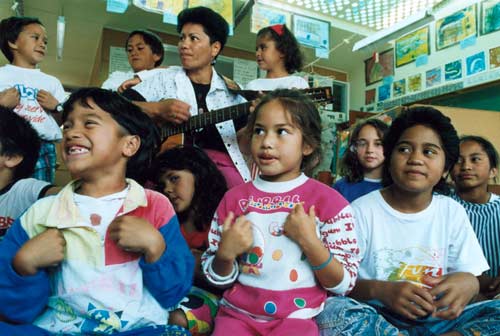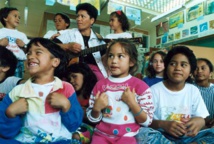Although they were both fluent speakers of te reo Maori (literally, the Maori language) they believed that learning English and other languages would be more beneficial for his future.
Instead, White studied French for five years.
”While not blaming my parents, [and saying] how wrong they were, French was of little use to me. But finding myself in the Maori world has meant everything to me, including becoming proficient in te reo,” the 63-year-old Maori cultural leader says.
Today he leads the initiative to turn Rotorua, a tourism magnet in the country’s North Island, into New Zealand’s first bilingual city. Bilingual street signs will soon be erected, and ideas such as bilingual menus, gym sessions and rewards for locals and tourists who use te reo are being discussed.
White’s story is typical for the baby boomer generation of New Zealand’s indigenous Maori, whose parents were punished for speaking their ancestral language in school.
Until 1860 te reo Maori was the dominant language in New Zealand and many of the predominantly British settlers became fluent speakers. But as the newcomers became the majority, English took over as the prevalent language in the country and te reo was soon confined to Maori communities.
After World War II many Maori moved to the cities to find work and often became alienated from their culture. The use of the Maori language declined rapidly and by 1980 only about 20 per cent of New Zealand’s indigenous population were able to hold a conversation in te reo.
Around that time initiatives to ensure the survival of the language were launched. In 1982 the first full language-immersion kindergarten (kohanga reo, meaning language nest) was opened. Today approximately one fifth of all Maori children attend a kohanga reo to learn their ancestors' language, culture and traditions.
A significant milestone in the revival of the language was when te reo was made an official language of New Zealand in August 1987.
Maori Language Commission Chief Executive Ngahiwi Apanui says that in the 30 years since then there has been a huge increase in Maori language education. Maori broadcasting has expanded to 22 radio stations and two television stations, and the language is used frequently in parliament and at formal events.
Today about 130,000 of the 600,000 Maori living in New Zealand have conversational fluency, 300,000 are learning the language at school and 10,000 in tertiary education.
But in comparison to Wales, another country that is fighting for the revitalization of a minority language - and where Welsh classes are compulsory in schools - Maori is only taught in about a quarter of New Zealand schools.
There is a greater demand to learn te reo, Apanui says, but there is not enough supply at the moment and greater investment in teaching is needed.
Rawina Higgins from Wellington’s Victoria University, who has studied revitalization efforts of te reo, says that just offering the language in schools will not guarantee its survival.
While New Zealand has been trailblazing with initiatives such as the kohanga reo, it is important to understand that language revitalization is a marathon rather than a sprint, she says.
"As it is commonly understood, 'It takes one generation to lose a language and three to restore it,'" she says. "Reversing language shift requires a lot of effort over a long period of time that re-establishes the language back into homes to become the first language of a family again.”
Many people see compulsory Maori classes for all New Zealand children as a vital step for the survival of the language. But Higgins says other elements, like friends, status and critical awareness, also play major roles.
That’s why initiatives that bring the language to life and make it relevant for a younger generation are so important. Despite the many initiatives to grow the use of te reo, it is still on UNESCO's list of endangered languages.
This month will see the release of the Disney blockbuster Moana, which is based on Polynesian myths, dubbed into te reo.
Sixteen-year-old Jaedyn Randell, who voices the Maori Moana, says media like music and film are key "because they allow Maori at all levels of understanding to make connections to their culture and celebrate who we are as Maori.”
The teenager from Tokoroa in central North Island went to a kohanga reo and studied the language at school. She hopes that the film will support the revitalization of the language.
“It makes links to our own myths and legends so we already feel connected to it,” she says.
Kiwi filmmaker Taika Waititi, who spearheaded the Maori version of the movie, says translating mainstream films into the Maori language had been a dream of his.
"For indigenous audiences to hear films in their own language is a huge deal, helping to normalize the native voice and give a sense of identification,” he explains.
“It also encourages our youth to continue with their love and learning of the language, letting them know their culture has a place in the world."
------------------------------------------------------------------------------------------------------------------------
Instead, White studied French for five years.
”While not blaming my parents, [and saying] how wrong they were, French was of little use to me. But finding myself in the Maori world has meant everything to me, including becoming proficient in te reo,” the 63-year-old Maori cultural leader says.
Today he leads the initiative to turn Rotorua, a tourism magnet in the country’s North Island, into New Zealand’s first bilingual city. Bilingual street signs will soon be erected, and ideas such as bilingual menus, gym sessions and rewards for locals and tourists who use te reo are being discussed.
White’s story is typical for the baby boomer generation of New Zealand’s indigenous Maori, whose parents were punished for speaking their ancestral language in school.
Until 1860 te reo Maori was the dominant language in New Zealand and many of the predominantly British settlers became fluent speakers. But as the newcomers became the majority, English took over as the prevalent language in the country and te reo was soon confined to Maori communities.
After World War II many Maori moved to the cities to find work and often became alienated from their culture. The use of the Maori language declined rapidly and by 1980 only about 20 per cent of New Zealand’s indigenous population were able to hold a conversation in te reo.
Around that time initiatives to ensure the survival of the language were launched. In 1982 the first full language-immersion kindergarten (kohanga reo, meaning language nest) was opened. Today approximately one fifth of all Maori children attend a kohanga reo to learn their ancestors' language, culture and traditions.
A significant milestone in the revival of the language was when te reo was made an official language of New Zealand in August 1987.
Maori Language Commission Chief Executive Ngahiwi Apanui says that in the 30 years since then there has been a huge increase in Maori language education. Maori broadcasting has expanded to 22 radio stations and two television stations, and the language is used frequently in parliament and at formal events.
Today about 130,000 of the 600,000 Maori living in New Zealand have conversational fluency, 300,000 are learning the language at school and 10,000 in tertiary education.
But in comparison to Wales, another country that is fighting for the revitalization of a minority language - and where Welsh classes are compulsory in schools - Maori is only taught in about a quarter of New Zealand schools.
There is a greater demand to learn te reo, Apanui says, but there is not enough supply at the moment and greater investment in teaching is needed.
Rawina Higgins from Wellington’s Victoria University, who has studied revitalization efforts of te reo, says that just offering the language in schools will not guarantee its survival.
While New Zealand has been trailblazing with initiatives such as the kohanga reo, it is important to understand that language revitalization is a marathon rather than a sprint, she says.
"As it is commonly understood, 'It takes one generation to lose a language and three to restore it,'" she says. "Reversing language shift requires a lot of effort over a long period of time that re-establishes the language back into homes to become the first language of a family again.”
Many people see compulsory Maori classes for all New Zealand children as a vital step for the survival of the language. But Higgins says other elements, like friends, status and critical awareness, also play major roles.
That’s why initiatives that bring the language to life and make it relevant for a younger generation are so important. Despite the many initiatives to grow the use of te reo, it is still on UNESCO's list of endangered languages.
This month will see the release of the Disney blockbuster Moana, which is based on Polynesian myths, dubbed into te reo.
Sixteen-year-old Jaedyn Randell, who voices the Maori Moana, says media like music and film are key "because they allow Maori at all levels of understanding to make connections to their culture and celebrate who we are as Maori.”
The teenager from Tokoroa in central North Island went to a kohanga reo and studied the language at school. She hopes that the film will support the revitalization of the language.
“It makes links to our own myths and legends so we already feel connected to it,” she says.
Kiwi filmmaker Taika Waititi, who spearheaded the Maori version of the movie, says translating mainstream films into the Maori language had been a dream of his.
"For indigenous audiences to hear films in their own language is a huge deal, helping to normalize the native voice and give a sense of identification,” he explains.
“It also encourages our youth to continue with their love and learning of the language, letting them know their culture has a place in the world."
------------------------------------------------------------------------------------------------------------------------









 Home
Home Politics
Politics











